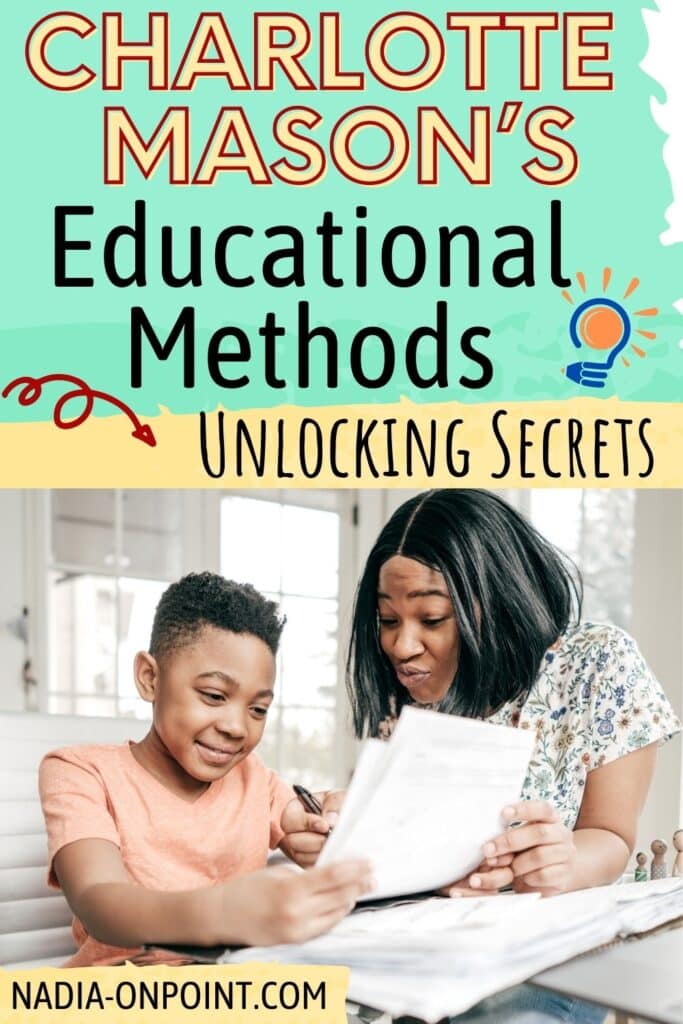While there are a handful of dedicated Charlotte Mason schools around the world, Mason’s name is most prominent in the homeschooling community.
As parents choose from an array of teaching styles, looking for the one that best suits their values as well as their learners’ needs, some find that Charlotte Mason hits the mark. Is this method right for you?

What Is The Charlotte Mason Home Education Style
The Charlotte Mason home education style is a method of teaching that emphasizes the importance of developing a child’s intellect, character, and habits. The philosophy holds that children should be given various experiences to develop their minds rather than just focusing on rote learning.
Charlotte Mason was born in Wales in 1842 and passed away in Ambleside, England, at the age of 81. The name Ambleside now appears in many Mason-inspired contexts, including Ambleside Schools International, an organization that supports the development of schools that operate in a Charlotte Mason style.
Mason’s life as a Brit during the Victorian Era certainly influenced the development of her philosophy and methods, aligning with the rising liberal values of the time (a word that carries a very different meaning today). She believed that education was integral in developing young children into whole, well-rounded persons with good habits, healthy bodies, broad and formidable knowledge, and abiding faith in God.
In other words, she valued the growth of mind, body, and spirit.
Mason did not develop a curriculum you could simply purchase and implement in any old home. Rather, she positioned education holistically so that the right environment is essential to authentically implementing her method.
Philosophy of Education
Mason famously asserted, “Education is an atmosphere, a discipline, a life.” This could be the Charlotte Mason tagline. Let’s examine this message:
Atmosphere
- In keeping with Victorian values, Mason emphasized “noble ideas,” including high-quality literature (living books), nature study, foreign languages, and the arts. She found it crucial for children to develop within an engaging and intellectually stimulating environment.
Discipline
- Mason espoused what she called “habit training,” which essentially meant developing lifelong habits related to strong character. She emphasized obedience to authority, consistency, daily practice, and praise.
Life
- In a Charlotte Mason School, students develop strong habits and vibrant ideas as part of their core identity, which they will carry into adulthood. She believed the mind must be fed ideas just as the body requires food.
These pillars underpin all of Mason’s work.
Structure of The Method
To support each facet of this philosophy, Charlotte Mason’s lessons are short and numerous. This allows learners to discover a huge variety of topics over the course of a week (although lessons do lengthen a bit as children get older and more focused).
A Mason education also includes rote memorization as well as copy work. These are intended to strengthen the mind and improve handwriting.
Importantly, this model of schooling is designed and led by the teacher or parent, not the learners. It is up to adults to determine what information and experiences offer the most value and to enforce children’s engagement with the highest quality materials and topics. Mason found this essential in guiding children toward becoming morally good adults who would contribute to society.
Lessons include a mix of reading from living books, exploring primary sources, and spending time outdoors. Mason students will not likely encounter any worksheets but instead spend time gathering information, interacting with the world, and practicing meaningful tasks.
A great way to find hands-on material that follows the Charlotte Mason principles is through an educational subscription box for home school. This way, your kids will receive new hands-on science, technology, mathematics, and engineering experiments every month.
Nature Study
Nature study is a core component of Charlotte Mason’s educational methods, emphasizing hands-on learning and exploration.
The focus of nature study is to encourage children to observe and appreciate the natural world around them, creating a connection with the environment that fosters a love for learning.
To explore the outdoors the Charlotte Mason way, children are encouraged to engage in activities such as bird watching, collecting specimens like insects and plants, or identifying plants and animals in their natural habitats.
Nature study allows children to connect with their surroundings and helps them develop important skills such as observation, critical thinking, and problem-solving.
Through observing patterns in nature, children can learn about cause-and-effect relationships and develop hypotheses about how different phenomena work. Moreover, it can be an opportunity for parents to spend quality time with their children while exploring the beauty of the great outdoors.
Aims and Goals
A Charlotte Mason education aims to respect and educate children as whole persons: mind, body, and spirit. The goal is to support young people grow into well-rounded adults and great thinkers who possess a strong sense of discipline and drive.
Learners are encouraged to prioritize God’s word above all and to honor the divine creation in the natural world. However, some homeschooling parents have found ways to secularize a Charlotte Mason education while preserving other key values.
Changes to Modern Education
The learning environment represents one of the biggest differences between Charlotte Mason’s ideal and typical classrooms today. Unless they attend a specific forest school, most school-age children today spend very little time outdoors as part of their formal education experience.
Learning is increasingly less exploratory and immersive, with more worksheets and literacy-based projects. Homeschool parents are looking to remedy this and educate kids about exploring their environment—something the Department of Education hasn’t done well.
In fact, the overall method of literacy instruction is another major difference from today’s pedagogy. Mason’s whole-language approach relies on engaging high-quality narratives and informative primary sources without explicit direct phonics instruction. Conversely, phonics plays a significant role in modern literacy development practices.
Like phonics instruction, teaching in our modern society is increasingly decontextualized and made more explicit. That is, children learn discrete skills and concepts, often through the use of dry textbooks. This represents a huge departure from Mason’s living books and firsthand experiences that engage mind, body, and spirit.
Charlotte Mason Method Challenges
One of the biggest challenges in implementing Charlotte Mason’s educational methods is overcoming the traditional view of education we get from public schooling.
It also presents some challenges, particularly for those used to more standardized private-school curricula. One of the main challenges is the need for parents and teachers to invest time in building a customized curriculum that fits each student’s needs.
Charlotte Mason’s principles are also seen as the Christian homeschool method. While the lessons and philosophy attract Christian homeschool parents, the methods can be used by anyone that wants individualized lesson plans for their kids.
Mason believed that education should be a living, breathing thing that encompasses all aspects of life, not just what is found in textbooks. This approach requires a shift in mindset for both educators and students who are used to following a strict curriculum.
Adapting to technology can also pose challenges when implementing Charlotte Mason’s methods. While technology can enhance learning experiences, it can also be a distraction from true engagement with the world around us.
Finding ways to incorporate technology while still maintaining a focus on hands-on experiences and nature-based learning can be challenging but essential for success with this method.
What Is The Difference Between Charlotte Mason and Montessori?
Charlotte Mason and Maria Montessori were contemporaries, though Montessori lived and worked in Italy. Their cultural and geographic differences undoubtedly played a part in their divergent views on education.
Charlotte Mason:
- Focuses on the role of the teacher as a guide and mentor
- The curriculum is centered around “living books” and real-life experiences
- Believes in the importance of a liberal arts education, including history, literature, poetry, music, and art
- Encourages children to spend time in nature and learn from the natural world
- Advocates for short lessons and limiting time spent on formal academics
Montessori:
- Education should be child-centered and self-directed
- Focuses on the role of the teacher as an observer and facilitator
- The curriculum is centered around the child’s interests and abilities
- Encourages children to work independently and at their own pace
- Advocates for mixed-age classrooms to promote social development and peer learning
Sense and Sensibility
Charlotte Mason pointedly disagreed with a few of Montessori’s methods while respecting others. Specifically, Mason could not accommodate the Montessori focus on sensory-based lessons, believing instead that focusing on the intellect and discerning meaning through the mind was best.
She emphasized a higher degree of imagination, creative thought, and fewer practical tasks.
Teachers vs. Students
Perhaps the biggest philosophical difference between these two revolves around the roles of teacher and student. While Mason’s instruction was decidedly teacher-led and prescribed, Montessori believed in a child-led approach.
A Montessori education allots long stretches of time for children to involve themselves in self-directed tasks. This is in sharp contrast to the shorter, varied lessons presented by Charlotte Mason.
Parent Involvement & Resources
Plenty of resources are available to assist parents that align with Charlotte Mason’s educational principles. These resources include books on parenting and education, online communities where like-minded individuals can connect and share ideas, and podcasts and blogs that offer practical advice on implementing Charlotte Mason’s approach at home.
To help supplement material, parents should look into modern screen-free science lessons that still follow Charlotte Mason’s principles. Most of these educational subscriptions come with all materials needed for STEM experiments. Here is an excellent list with hands-on reviews of the best educational subscriptions for kids.
Wrapping up The Benefits of Charlotte Mason’s Method
As with any educational method, Charlotte Mason’s style is likely a good fit if you share her values. The philosophy may be right for you if you believe that children need specific direction, good habits, and a broad education that includes key subject areas (like literature, foreign language, and the arts).
This learning style may benefit youth who prefer shorter lessons, a lot of variety, great books, and hands-on nature learning. It may be less well-suited to students with specific sensory needs.
Adapting curriculum to student needs is one of the most powerful skills any teacher can learn. If you want to get started with Charlotte Mason, be prepared to tweak the methods to suit your unique learners best.
This article originally appeared on Wealth of Geeks.
More Ideas from this Category
About the author
Krystal DeVille
Krystal DeVille is an avid believer in the power of education, particularly in STEM fields. She is a dedicated homeschool mom to three amazing children and the founder ofSTEM Education Guide. Her mission is to make science, technology, engineering, and mathematics accessible to everyone by providing resources for teachers, parents, and students alike.







